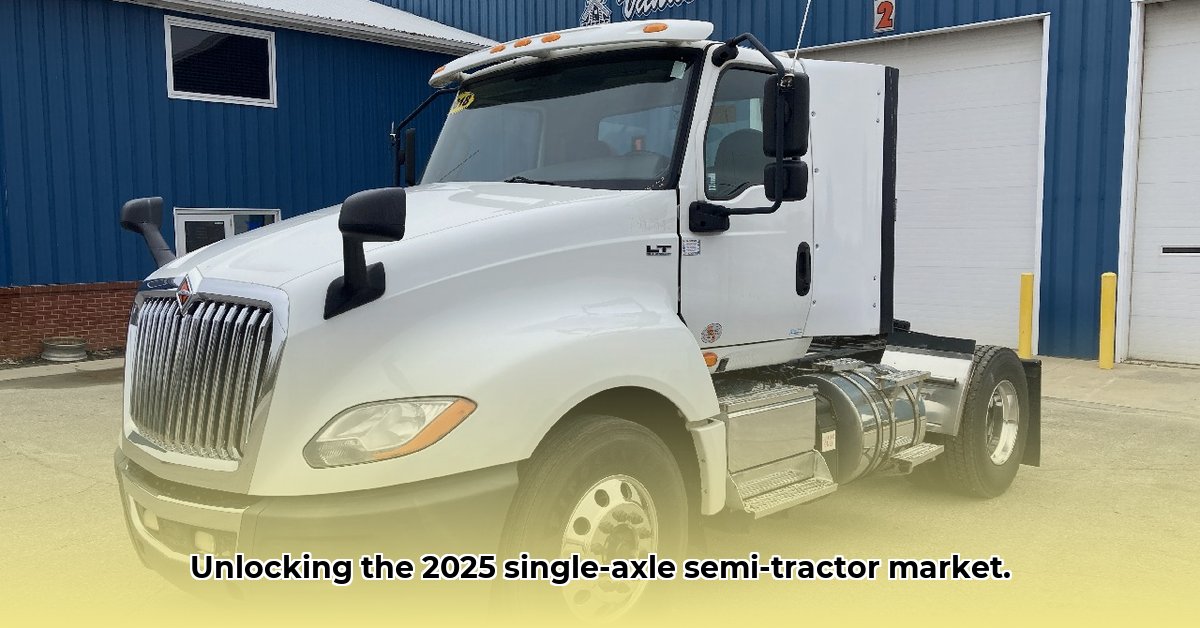
Understanding the Single-Axle Semi-Tractor Market in 2025
Single-axle semi-tractors, also known as single-axle day cabs, represent a significant segment within the commercial trucking industry. Their maneuverability and fuel efficiency make them particularly well-suited for short-haul operations, last-mile deliveries, and urban environments. However, the market is dynamic, influenced by factors like fluctuating fuel prices, increasingly stringent emissions regulations, and evolving technological advancements. This guide provides a comprehensive overview to help stakeholders make informed decisions in this competitive landscape. For more detailed information on tractor purchasing, check out this helpful tractor buying guide.
Market Overview: Size, Players, and Regional Variations
While precise market size data for single-axle semi-tractors remains elusive, the sector is demonstrably robust and growing. Key players include major truck manufacturers such as [Insert Manufacturer Names Here – requires research to populate], each offering varying models with distinct features and specifications. Regional variations in demand exist; for example, densely populated urban areas generally see higher demand than rural regions due to the efficiency of these trucks in navigating congested streets. Data regarding average pricing and mileage varies widely based on age, condition, and specifics of the vehicle. Further research is necessary for a precise analysis of cost and mileage averages by location. Do you need a visualization of this data? (Insert Chart/Graph showing regional market data here – requires research to populate)
Technical Specifications and Features: A Deep Dive
Single-axle semi-tractors offer a range of engine types, including diesel, compressed natural gas (CNG), and increasingly, electric options. Fuel efficiency is a paramount concern, with manufacturers continually striving to improve mileage through design innovations and engine technology. Payload capacity varies depending on the model, typically ranging from [Insert Range – requires research to populate] pounds. Common safety features include electronic stability control (ESC), anti-lock braking systems (ABS), and advanced driver-assistance systems (ADAS). Detailed specifications should be carefully reviewed from individual manufacturers' official sources.
(Diagram/Illustration of a single-axle semi-tractor with key components labeled – requires creation)
Operational Considerations: Cost, Maintenance, and Route Optimization
Owning and operating a single-axle semi-tractor involves several key considerations. Fuel costs are a major expense, impacted by fuel prices and driving habits. Regular maintenance is essential for maximizing lifespan and minimizing downtime. Driver comfort and training should be considered for worker satisfaction and safety. Route optimization, using GPS and route planning software, can dramatically reduce fuel consumption and operational costs. Finally, regulatory compliance, particularly concerning emissions standards, is paramount and requires ongoing awareness. How can you maximize your return on investment in this sector?
Actionable Insights and Recommendations: Strategies for Success
Fleet Managers: Prioritize fuel-efficient models, implement telematics for route optimization and preventative maintenance, and invest in driver training programs focused on fuel-efficient driving techniques. Consider exploring alternative fuel options (CNG, electric) for long-term sustainability.
Owner-Operators: Focus on efficient route planning, maintain meticulous records of fuel consumption and maintenance, and explore financing options that align with your operational needs. Continuously evaluate and adapt to changing fuel prices and market demands.
Truck Manufacturers: Invest further in research and development of fuel-efficient and alternative fuel technologies. Cater specifically to the needs of urban delivery operations through design and technological features.
Parts Suppliers: Anticipate future demands by stocking parts for popular models and emerging technologies. Build relationships with manufacturers to secure timely delivery of crucial components.
Future Trends and Forecasts: Shaping the Landscape
Several trends are set to shape the future of the single-axle semi-tractor market. Stricter emission regulations globally will inevitably drive the adoption of alternative fuel technologies, like CNG and electric vehicles. Advancements in ADAS will likely enhance safety and fuel efficiency. The increasing demand for e-commerce and last-mile delivery services further fuels the market. As technology develops, what will be the next major development in the single-axle semi-tractor industry?
Conclusion: Navigating the Market for Success
The single-axle semi-tractor market presents both challenges and opportunities. By understanding the market dynamics, technical specifications, operational considerations, and future trends, stakeholders can position themselves for success. Continuous adaptation and a focus on efficiency, safety, and sustainability are critical for navigating this evolving sector. Continuous monitoring of market trends and technological advancements is critical for sustained success.